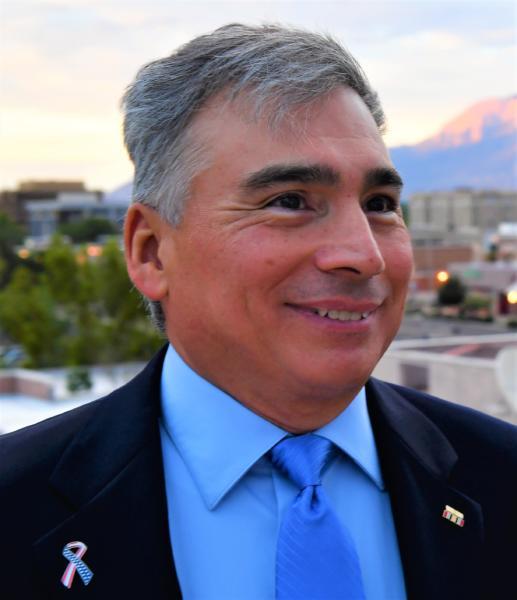.jpg) The Republican Party of New Mexico has just come through its third straight disastrous cycle—all of which have been under either the direct personal leadership or the direct influence of former Congressman Steve Pearce. Now Pearce, who is 73, is running yet again for state party chair, seeking to be the "man behind the curtain" for the fourth consecutive cycle.
The Republican Party of New Mexico has just come through its third straight disastrous cycle—all of which have been under either the direct personal leadership or the direct influence of former Congressman Steve Pearce. Now Pearce, who is 73, is running yet again for state party chair, seeking to be the "man behind the curtain" for the fourth consecutive cycle.
GOP State Central Committee members meet tonight—Monday night at 7:00 PM—via Zoom, to decide who will chair the party for the next two years. The Pearce organization has the upper hand, precisely for the same factors that affect everything during the "Pandemic Era" — inertia.
COVID-19 is the go-to excuse for non-action, for keeping things the same, for eliminating actual discussion, for grotesquely affecting the dynamic badly needed in so many different aspects of life. In the case of a political party meeting, the current situation favors the existing structure, no matter what the subject matter is.
It was the Pearce organization who got the RPNM on this rushed-up schedule, just a month after the election. In our view, this is a terrible idea: It needless hurries the process for picking new party leadership just a few days after the previous election has been certified. In reality, political parties need time to sit back and fully assess what has just transpired. Rushing to set up a new structure in the middle of the Thanksgiving-Christmas season is a ridiculous rule. It should be abolished, and the chairmanship election should be set in April of each odd year.
So, is the Chairmanship even Worth Worrying About?
Probably it is. After all, lightning can strike. Biden has the potential to be such an amazing disaster that he could turn thousands of traditional Democrats against the party of their birth. Who knows? It certainly appears that 2022 could be a great year for Republicans, across the nation, and in New Mexico.
The state chair has traditionally had to be someone with the ability to raise money—to have money himself or herself and the ability to tap into wealthy donors through connections they have both in-state as well as through a nationwide network of political connections.
 Pearce, though disastrous as the “leader” (whether de facto or de jure), appears, on paper at least, to likely be the only candidate with those kinds of possible connections. However, that is only in "theory." In practice, Pearce’s actual fundraising has been desultory and lots of legislative candidates got very little or no help from the oil and gas interests that he was supposed to bring to the table.
Pearce, though disastrous as the “leader” (whether de facto or de jure), appears, on paper at least, to likely be the only candidate with those kinds of possible connections. However, that is only in "theory." In practice, Pearce’s actual fundraising has been desultory and lots of legislative candidates got very little or no help from the oil and gas interests that he was supposed to bring to the table.
The big money that did reach the party was from national sources that would send money to the state party regardless of who occupies the state chair.
Nonetheless, Pearce understands fundraising and certainly appears to most likely be more capable in that regard than the other candidates. So that favors him. Additionally, Pearce—as he has bragged—has the personal organization around the state.
Of course, that personal organization has had no success in winning elections around the state, but it is extremely useful in capturing and holding the chairmanship itself.
The most alarming thing about the Pearce candidacy is the insistence among those in the know that he is once again using the position or the control of the party apparatus to advance his own plans to—once again—run for governor. It would be his fourth effort to win a statewide race. The three previous efforts have ended in catastrophic landslide defeats.
Who Else is Running?
The other candidates are Eddy Aragon, Eric Lucero, and Geoffrey Snider.
 Eric Lucero is a popular, likable, 63-year-old (who looks much much younger), well-meaning frequent volunteer worker, but as far as we know has no experience in running a major organization, and appears to have only a limited ability to raise funds. At least he has been a Republican for a long time, and, also unlike Aragon, he's voted in every single election, 15 straight, general, primary, and municipal.
Eric Lucero is a popular, likable, 63-year-old (who looks much much younger), well-meaning frequent volunteer worker, but as far as we know has no experience in running a major organization, and appears to have only a limited ability to raise funds. At least he has been a Republican for a long time, and, also unlike Aragon, he's voted in every single election, 15 straight, general, primary, and municipal.
.jpg) Eddy Aragon is a 45-year-old broadcaster. Oddly, he's only been a Republican for less than a year, which, not surprisingly, means he's only voted in one primary in the past decade. As usual, he appears to be using this opportunity for cheap publicity, to prompt more attention and business for his radio station. His radio show has (at best) an “extremely modest” audience that doesn’t actually know who he is. Those who are close to campaign organizations know that he tries to “sell” interviews to candidates, something that is not done by legitimate media organizations.
Eddy Aragon is a 45-year-old broadcaster. Oddly, he's only been a Republican for less than a year, which, not surprisingly, means he's only voted in one primary in the past decade. As usual, he appears to be using this opportunity for cheap publicity, to prompt more attention and business for his radio station. His radio show has (at best) an “extremely modest” audience that doesn’t actually know who he is. Those who are close to campaign organizations know that he tries to “sell” interviews to candidates, something that is not done by legitimate media organizations.
Plus, Aragon, as previously noted, has been all over the political spectrum—repeatedly threatening to run as an independent for the US Senate in 2019 and 2020, while at one time or another attacking every single Republican hopeful: Elisa Martinez, Mick Rich, Gavin Clarkson, and Mark Ronchetti, calling all of them “worthless.”
Clarkson took the hint towards the end of the primary campaign, purchased some air time, and suddenly became—in Eddy's view—a much more "worthy" candidate. Pearce himself has made arrangements with Aragon, and according to sources, has paid him quite a bit to air Pearce's own radio shows, as well as those of his protégés. (It would be interesting to see state party records to verify how much has been paid to Aragon.)
Eddy—at least in the image of his most recent version of himself (which is ever-changing)—now regularly attempts to identify with the most aggressive positions possible. His history, however, indicates that such positions are far from stable, let alone permanent.
He is related to Raymond and Michael Sanchez, and has worked for prominent Democrats, including Tom Udall and General Wesley Clark. He also brags about having been married to a “coyota” — a woman who helped illegals cross the border.
He also had an abortive run for Mayor of Albuquerque, but quit after collecting 5-dollar contributions, which he neither filed, accounted for, or returned to donors. Aragon is also advocating for equal funding of all candidates, without regard for the winnability of particular races. This of course is a naive and highly wasteful approach and one that can only end up in lots of money being directed to districts that are impossible to win, while underfunding those candidates who can win. So all that is extremely problematic.
- This leaves 43-year-old Geoffrey Snider. We don’t know if he can raise money, but he says he can, and he has definitely written the best
 letters to the central committee. He owns his own business, FOAC, LLC, and, again unlike Aragon, he has voted in every single election of all kinds for the past decade.
letters to the central committee. He owns his own business, FOAC, LLC, and, again unlike Aragon, he has voted in every single election of all kinds for the past decade.
Snider has recently been serving as the Executive Director of the Bernalillo County Republican Party, where he says the party has set an all-time record in fundraising. His letters discuss his ideas about ways to redirect and reorganize and focus the state part
It appears that Snider is far and away the best choice at this juncture.
To Recap the Last 8 Years:
- In 2014, a Susana Martinez-led coordinated effort captured the statehouse for the first time in 60 years. When the dust had settled, Republicans held a 37-33 advantage in the State House.
- In 2016, a Pearce-led effort persuaded House Republicans to abandon Martinez’s successful strategy, with the result being the loss of 5 seats—and the majority it had taken six decades to achieve.
- For 2018, as Pearce gave up his safe CD 2 seat to run for governor, he secured the chairmanship for his acolyte (and fellow Martinez hater) Ryan Cangiolosi, resulting in the most disastrous cycle for the Republican Party in 106 years of statehood: Republicans lost an additional 8 House seats, making a net loss of a whopping 13 seats in just two years. Democrats held a 46-24 advantage. The GOP lost all twelve statewide races plus all four federal contests, for an astounding 0 for 16 result—something that had never happened before.
As part of the catastrophe, Pearce’s hand-picked replacement ran a weak race and actually managed to lose CD 2, which is designed to be a Republican seat.
- As for 2020, just a month after his 2018 debacle, Pearce got himself installed as Chair for the 2020 cycle, by bragging about losing the governor's race by 100,000 votes (we are not making this up) and promising “a new vision.”
In Pearce’s 2018 Letter, He Made a Number of Promises
Here is what Pearce stated:
“I know there are others who will want to run for leadership of the party but the big question is, how long will it take for them to develop the people and talent in every county?”
“I have been constantly "on the ground"…for the last 16 years and have personally established a network of supporters…We have built a great organization and, yes—we are going to keep it going…This provides me with a strong base of "new friends" that I can build on for the party.
COMMENT: The problem appears to have been his continuous references to what he personally had established for himself—to win election to state chairmanship, to arrange to win primaries for candidates who belong to “HIS” organization, as opposed to the state party itself.
He claimed to have “invested $5 million” in developing what he called “a base message that the State GOP can build on even further for 2020.”
He went further, stating that:
“I am a seasoned communicator. I know all the key people in the TV stations, all the radio stations across the state and am well acquainted with those in the print media…No one else in the party…has a skillset of campaign and business experience, the grit, the network of committed volunteers that I have assembled…No one…has been to more towns and villages that I have been in, or developed the relationships in every county that I have…
He went on:
“I have personally talked and listened to over 10,000 people…and have gone to every county and over 100 small and large towns, to reservations and chapter houses…I know and work well with leaders in all cultures; Hispanic, Native American, African-American, Asian and Middle Eastern. Anyone else who might be elected as State Party Chair will start at ground zero and need years to travel to the places that I have been and organized over the last 16 years.
Of course, these claims tended to beg the question: If Pearce has everything in the world going for him, how come it doesn’t result in a victory—of some kind? Or, possibly this question: How does all that result in getting beat by 100,000 votes? But we digress.
Pearce went on:
“We are going to recruit more [millennials] …and put them in key positions in the party as we move forward…We are going to recruit new, younger, and talented people. “We will create a strong social media presence…Speed and commitment are essential. Our leaders must hit the ground running in January 2019 to prepare for 2020-with new energy, new commitment and new turnout targets for winning each and every election when called upon.
"We will also establish a statewide policy coordinating committee to hold elected officials accountable for their actions, and I believe we must also have our own independent polling operation.
“The renewed Republican party will function like a growing business…
He promised to “act boldly…be more strategic…inclusive, and united, to build coalitions,
So, did Any of that Take Place? As Best We Can Tell, NONE of That Actually Happened
So, what really did happen?
Pearce spent his entire two years engaging in divisive, grudge-holding maneuvers, making sure that the first Hispanic female governor in the history of the country—and by all measures, the most successful—was not invited to conventions, and was never used as an example of what can be done.
Pearce again used divisive tactics in primaries—inserting himself and state party assets into intra-party contests.
The result was—again—the loss of every single statewide race—all five of them! Republicans did regain CD2, which should never have been lost in the first place, because of the design of the district. Republicans also picked up one (1) of the 13 state House seats the Pearce team had lost over the previous two cycles. But they lost a seat in the Senate. When all was said and done, the Pearce-led coalition of “Republican leaders” have gone from a 37-33 Republican House and 18 Senate Republicans to a 25-45 House deficit, with only 15 Republican Senators left.
Additionally, Trump lost the state in a landslide, despite Pearce’s promises. The one bright spot was the showing of Senate candidate Mark Ronchetti, who was ignored by Pearce, mainly because Pearce “sees him as somehow an ally of former Governor Martinez.” Some leadership.
So' Pearce Declares “Victory” and Boldly Announces He Needs Another Term as Chairman
Just a few days ago, Pearce sent out a bizarre letter to the GOP State Central Committee. In it, he makes claims that no one can even understand, much less believe. Here are some of them:
“During the past two years, RPNM has made history in our great state, reaching remarkable milestones and surpassing many of its goals. I would be honored to serve another two years to further play a vital role in its continuing success.”
What? When and where did any of this happen?
“The Republican Party has become dynamic, truly diverse and extremely driven. RPNM has received national acclaim during this recent election, and many more New Mexicans have eagerly embraced the Party’s message and mission.”
Comment: Republicans may properly respond that they wish all of this, or any of this, were true. But it is painfully obvious that it’s not.
Pearce went on:
“As your Chairman for the last year, I have witnessed extraordinary achievements by our staff and supporters…In short…RPNM has become stronger and more influential. It is for these reasons that I plan on running for another term as your Chairman.”
The New Mexico Republicans’ Dilemma
The Republican Party is in tatters in New Mexico. However, the likelihood is that a President Biden will create a national mood which will probably be very favorable to the GOP in 2022. So, given a strong candidate (not Pearce) there should be a reasonably good chance that Republicans could capture the governorship, and perhaps (again with strong candidates) a decent chance at other statewide races.
Unfortunately, the favorable environment will almost certainly not help in the legislature. The Pearce team has left the GOP without a seat at the table for the most important factor of all: redistricting.
In 2001 and 2011, the legislative Republicans had Gary Johnson and Susana Martinez to veto the gerrymandered bills put forward by the Democrats—forcing the whole question of redistricting into court.
But for 2021, the GOP has neither house in the legislature, plus Pearce lost the governorship in a landslide, leaving the Republicans with no seat at the table. Brian Egolf has already signaled that he and the Democrats will run roughshod over the Republicans—including (as Egolf stated) taking away the Second Congressional District by means of a partisan gerrymander.
The choice of state chair may or may not have any effect at all. But New Mexico Republicans cannot be blamed if they choose not to go down the Pearce road yet again.
Email us (at editor@newmexicopoliticaljournal.com) with your feedback, comments, questions, and ideas.
Intelligent Political Discourse—for the Thoughtful New Mexican
.jpg)
